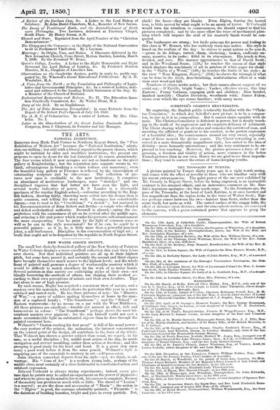NEW WATER COLOUR SOU Err.
The smalrbut choicely-furnished gallery of the New Society of Painters in Water Colours displays a more excellent collection this year than it has ever shown. Not that individual ,painters -are -all -up to their.ffiighest
pit a, but some have passed it, and certainly the second and third classes have brought themselves much nearer-to the .highest level; and the-whole
front of painted wallpresents a degree of workmanlike mastery which it would be difficult to match elsewhere by the work of so many hands. Several paintereln this society are .cultivating styles of their own—not
blindly borrowing the methods of others, but shaping their method ac- cording to their own perceptions of nature and their own _faculties. That fact -alone-is one of high promise.
By such means, liaghe has acquired a consistent view of nature, and a mastery over his materials, which shows its perfection this year in a more subdued and varied-style. Re has three pictures of note.: the "Miseries
of War,"—a party of soldiers making themselves at home in the man- sion of a captured family; "The-Guardroom " ; and the "Scheel" or
Eastern waterworks—by no means on a par with the West Middlesex. All these pictures are excellent,—forcible yet natural in effect, rich and harmonious in colour : " The Guardroom " perhaps shows the most tri- uniPhant mastery over pigment ; for the sun himself could not cast a more unmistakeable light on substantial objects than he does through the painted casement here. Wehnert's " Caxton reading his first proof" is full of his usual power : the easy posture of the printer, the animation, the interest concentrated
on the central point of the design, all contribute to the force of the whole. That Wchnert has chosen a quieter subject than usual, we regard, in his -ease, as a useful discipline ; -for, unlike most artists of the day, he needs ' castigation and stricter moulding, rather than action or freedom; and this grouping is geed study for his head and hand. It is a great step upon many a good work before it from the same pencil. Wehnert's style is acquiring one of the essentials to mastery in art—self-possession. .John Absolon somewhat departs from his style—not, we think, to ad- vantage. His "Joan of Are" is a modern young lady, perhaps of the middle chrka, most certainly of a class habituated to constrained action and subdued expression.
Edward 'Corbould is always trying experiments ; indeed, every pie- tare that he paints may be called an experiment on the power of pigments ; ' and where he gives up his mind to his work, his success is complete. No man of theeociety can produce so much with so little. The shawl of "Louisa " isa marvel ; so are the dress and accessories of " Maria" ; the action in the " Elgiva" is good, the costume admirably-painted; " Fleurette " is 1 the daintiest of budding beauties, bright and pure in every. particle. But,
slack r the faces—they are blanks. Even .FJgiva, fearing the heated iron, is little moved laywhat ought to be an agony of terror. If Corbould would turn his attention to countenances, we should expect to itadthis pictures completed ; and by the same effort the trace of merfflanicalphm- ning which still impairs the skill of his masterly finish would in .eon- quered.
The landscapes are strong ; but facile psincaps for power.and fesiiwgin this class is W. Bennet, who has suddenly risen into notice. -His styleis based on the realism of the day : he strives to paint nature as he sees It, —green in its foliage, varied, sharp, clustering.; broken, endlessly mt- same, massive, in its rooks ; fitful in its atmosphere. His touch is free, decided, and sure. lais manner approximates to that of David Scott; and in the Woodland Scene, (170,) ho reaches the excess of that style which displays the machinery of art in patches of white paper for elated : in the " Skirts of a Wood.;" (189,) he touches the limits of his style; in the view " Near Kingston, Surrey," (2/00 .heehows the triumph of what can be done in the fresh, freo-hreathing, multitudinbus effect of a -wide view over wood and hill.
Numbers of others.invite notice, but theirnanies almost suggest all we could say,—D'Eiville, bright Venice ; ■Vaeher, effective views, this time Eastern ; Fanny Corbaus, .engaging girls and children; Miss Setcdiel, finished morality.; Charles Davidson, woodlands wild ; James Fahey,
• dews over which the eye roams familiar; with many more.


























 Previous page
Previous page